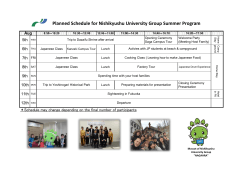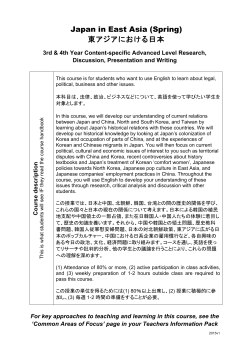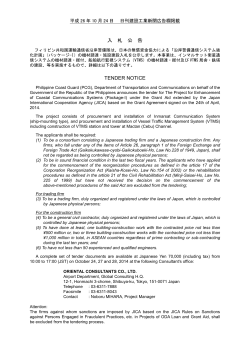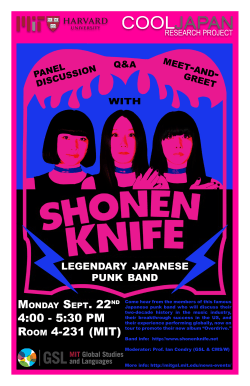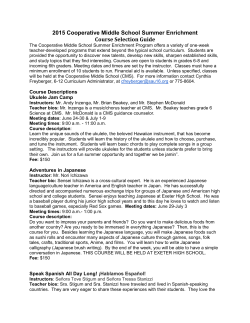
PID Curriculum Guide for âThe Untold Story: Internment of Japanese
PARTICIPATION IN DEMOCRACY CURRICULUM PRIORITY OF LEARNING TARGETS HCPS III Benchmark: SS.9PID.5.1 Explain the rights, duties and responsibilities of citizens in a democracy and the relationship between them. CCSS Literacy in History/ Social Studies • 11-12. RH.1-3 Cite specific textual evidence to support analysis of primary and secondary sources, connecting insights gained from specific details to an understanding of the text as a whole. • 11-12. RH 2. Determine the central ideas or information of a primary or secondary source; provide an accurate summary that makes clear the relationships among the key details and ideas. GLO(S) • Self-directed Learner • Community Contributor • Complex Thinker • Quality Producer • Effective Communicator • Effective & Ethical User of Technology • 11-12. RH 3. Evaluate various explanations for actions or events and determine which explanation best accords with textual evidence, acknowledging where the text leaves matters uncertain. • 11-12 WH.1 Write arguments focused on discipline: specific content. Content (What are YOU going to teach within the time allotted to you?) Skills (from the benchmark/ pre-assessment data/school or grade level goals) • The role of the military and U.S. government during World War II in Hawai‘i. (martial law, suspension of writ of habeas corpus presidential powers, executive orders) • Analyzing reasons for internment of Americans of Japanese Ancestry during World War II. •Rights & responsibilities of American citizens. (1st, 5th, 13th, and 14th Amendment, due process) •Exercising rights and responsibilities of citizens. •Explaining the role of the military and the government during national emergencies. •Personal narratives from internees or internees’ Biographies. SECTION III | Participation in Democracy Curriculum 143 Technology Integration •Using “Glogster” (www.glogster.edu) and create a poster of what makes a person a “good” citizen. C3 Dimension •Construct compelling questions. •Using “Spreaker” (www. Spreaker.com), create a podcast on theme of rights & responsibilities of a citizen. •Write an essay on one of the following: “What is a “good” citizen?” or “Should national security ever override a person’s civil liberties?” •The class can publish the essay collection on “Issuu” (www.issuu.com) Charlotte Danielson Framework Domain(s) and Component(s) 3B. Use Questioning and Discussion Techniques 3C. Engaging Students in Learning Compelling Question •How can you hide 3,000 people on an island without anyone knowing about it? •When is it appropriate to speak up for injustice? •Under what circumstances can a U.S. President take away my rights? •Under what conditions could a person get arrested based on looks alone? Is racial profiling ever really necessary? Why or why not? Formative Instruction •Review Vocabulary terms: due process, presidential powers, 5th and 14 Amendments, martial law, discrimination, internment camps, writ of habeas corpus, redress, Executive Powers, Patriot Act. •View the DVD – The Untold Story: Internment of the Japanese Americans in Hawai‘i. Use the accompanying AVID strategy: Reciprocal Film Viewing Organizer. •Look at biographies of internees (personal narratives) mentioned in film and complete fill-in organizer in small groups. •Analyze Supreme Court case, Korematsu v. United States. * If time permits, and if students need added background knowledge, review Bill of Rights –1st, 4th, 5th, 13th, 14th Amendments, martial law, writ of habeas corpus. *If time permits, may review accounts of Americans of Japanese Ancestry who were interned at Heart Mountain and were members of the Fair Play Committee. (These men objected to enlistment into the Military Service since the U.S. government did not recognize citizenship and interned them and their families at the internment camps.) 144 SECTION III | Participation in Democracy Curriculum Differentiation Strategies •How can you hide 3,000 people on an island without anyone knowing about it? •When is it appropriate to speak up for injustice? •Under what circumstances can a U.S. President take away my rights? •Under what conditions could a person get arrested based on looks alone? Is racial profiling ever really necessary? Why or why not? Summative Assessment Task Students will take and defend a position on the following prompt: “Should national security ever override a person’s civil liberties?” Students may choose one of the following: written (essay), oral (podcast), or visual (poster) through which to convey their position. Students must support their assertions with clear and relevant details from the film The Untold Story: Internment of Japanese Americans in Hawai‘i and from other sources of information used in their research. Rubric for Summative Assessment Advanced The student takes and defends a position on the prompt, supporting his/her assertions using clear, precise, and highly relevant details from the film and from other sources of information from the research. Proficient The student takes and defends a position on the prompt, supporting his/her assertions using clear and relevant details from the film and from other sources of information from the research. Partially Proficient The student takes and defends a position on the prompt, supporting his/her assertions using some vague and tangential details from the film and from other sources of information from the research. Novice The student ineffectively takes and defends a position on the prompt. Lesson/Unit Plan (including relevant data, formative assessments, differentiation and engagement strategies, and digital literacy tool) Needs Assessment/Rationale: This social studies department focuses on Historical Habits of Mind and on using digital literacy. This lesson plan addresses both initiatives. In addition, 100% of students scored below “proficiency” on a pre-test of content knowledge Japanese American Internment. 1 DAY ONE Homework: Vocabulary terms and have the students work on Tri-column organizer (Handout). (20 minutes) Assess the student’s knowledge about World War II’s impact on the citizens of Hawai‘i with a K W L strategy or a variation of it or ask students what they already know about the topic. May want to re-teach basic information including: • Dec. 7th, 1941 bombing of Pearl Harbor naval base by the Japanese Imperial Navy; • Over 2,000 American servicemen and civilians lost their lives; • Japanese attack destroyed naval fleet and incapacitated the dock for several months; and • There were approximately 140,000 Japanese Americans of Japanese ancestry and aliens in Hawai‘i. Before showing the film, The Untold Story: Internment of Japanese Americans in Hawai‘i, review the Reciprocal Film Viewing Summary process (handout). Based on student needs, break the content of the film into small chunks that can be easily processed by students. Pause the film at key points for them to summarize, clarify, and ask questions. 2 DAY TWO Divide the class into groups of 3-5 students. Distribute personal narratives (internees’ biographies) (handout) and have students complete the graphic organizer (handout). (Allot 30 minutes). Bring entire class together for a whole class discussion around the following questions. (20 minutes) 1. What were these two men being suspected of at the time of their arrest? SECTION III | Participation in Democracy Curriculum 145 2. Were the civil rights of Sam Nishimura and Jack Tasaka violated? If so, which ones? 3. If these rights were violated, was it justified for the sake of national security? 4. In times of a national crisis or emergency, is it necessary to suspend some of our civil rights in order to achieve a sense of security? Why or why not? (Think back to when Hawai‘i was placed under martial law.) Exit Pass: 3:2:1 (5 minutes) Have the students indicate three things they learned, two things which they found interesting, and one compelling question they have about the narrative. (handout) 3 DAY THREE Review constitutional principles: Due Process (5th), Unreasonable Search and Seizure (4th), Habeas Corpus, and the principle called Presumption of Innocence. Explain the concept of a Dissenting opinion in a U.S. Supreme Court Case (to influence the other justices to change their minds in a court decision based on the dissenting judge’s opinion), and the distinction between the terms: Redress and Reparations. Review Korematsu v. United States, and use Marking the Text Strategy (Handout). To check for understanding, ask the students the following questions: 1. Why did Mr. Korematsu choose to challenge the exclusion order? 2. Why did the U.S. Court uphold the lower court’s ruling against Fred Korematsu? 3. What did the court say in regards to excluding Mr. Korematsu from the Military Area? Did he display any wrongful behavior or character? • Give the students the Constructed Response Statement (CRS). Prompt: Explain why Fred T. Korematsu was upset about his arrest, and later, incarceration at the internment camp despite his American citizenship. (Handout) The CRS is listed with steps for the students to complete in succession. Note in Step 2, teacher will add comments for the student to be able to revise. In the Step 3 block, the student can reconstruct his CRS from the comments made by teacher/coach. In Step 4, student would ask a peer to write a comment on his/her passage – peer review. After that step is done, the student will 146 SECTION III | Participation in Democracy Curriculum write a reflection before submitting the CRS for final grading. • It’s important to inform the students about the reopening of Korematsu v. U.S. Supreme Court Case in 1980 by President Jimmy Carter. He appointed a special commission to initiate a federal review of the facts of the incarceration of Americans of Japanese Ancestry. 4 DAY FOUR Assign them summative assessment: give the students a choice (differentiation of product), written, oral, or visual. Review rubric. Extension Activity: Hirabayashi, Yasui, and Endo v. United States. •Have the students read the background and the Court’s opinion. Have the students work in pairs or small groups on the case using similar strategy. •Distribute excerpts from 2002 Congressional Act – Patriot Act found in Constitutional Rights Foundation, Wartime and the Bill of Rights: The Korematsu Case. A Proper Balance. Divide the students into small groups of 3-5 and have them discuss whether individual rights are forsaken in times of national security and alarm. Remind the students that there is a delicate balance between national security and civil liberties during a domestic emergency. •Review article, Our Worst Mistake by Eugene V. Rostow, Harper’s Magazine, Sept. 1945 (Handout). Share with the students the five main propositions which the U.S. officials based their reasoning regarding the incarceration of Americans of Japanese Ancestry. The author also offers three forms of reparation that are available, and should be considered to correct the wrongs of violating the civil liberties of Americans of Japanese Ancestry. Note this article appeared in 1945, more than 40 years prior to the redress and reparations to Americans of Japanese Ancestry who were interned during World War II. •Correct terminology of words used during WWII involving the incarceration of Americans of Japanese Ancestry as studied and implemented by the Japanese American Citizens League. It might be ideal to show students how words have a different meaning depending on their usage. Furthermore, stating words in a particular time and place can have altered meanings/interpretation. The mere persuasion of particular words can influence the individual and community’s perception of an action or state of culture. (handout) ADDITIONAL INFORMATION • Ancestry Is Not A Crime: The Internment of People of Japanese Descent During World War II by Office of Instructional Services/General Education Branch, Dept. of Education, State of Hawai‘i, RS 94-6453, Nov. 1994 • Constitutional Rights Foundation, Wartime and the Bill of Rights: The Korematsu Case. A Proper Balance. www.crf-usa.org • Densho Institute. Site is dedicated to preserving the legacy of Americans of Japanese Ancestry during World War II. http://densho.org • Japanese American Citizens League. The Power of Words: A Correct Terminology Guide. http://pnwjacl.org/POW-1htm. • Korematsu, Fred T. “Don’t Be Afraid To Speak Up”. Korematsu Institute for Civil Rights and Education. San Francisco: California. 2013. • Rostov, Eugene V. Our Worst Mistake. Harper’s Magazine. Vol.191: No. 1144. September 1945. SECTION III | Participation in Democracy Curriculum 147 JACK TA SA K A EXCE R PT Excerpt from Confidential Stories at Honouliuli Japanese Internment Camp By Yoshitami “Jack” Tasaka “Crimes” I was in Hilo city of Hawai‘i Island on business for the period of spring to fall in the following year after the Pacific War broke out. Since I did not know how long my business would take, I had only one-way ticket. Accordingly, I was considered a resident of Hawai‘i Island, and could not come back to Honolulu; I was retained under the War Manpower Commission of Hawai‘i Island. After I hired an attorney to negotiate (my release), I was finally allowed to return to Honolulu. However, as if they were waiting for my return, Civil Intelligence Service and Army Intelligence started to question me, and I ended up being detained at the Immigration Station on April 3, 1943. After a perfunctory public hearing, they told me: - You are of dual citizenship. - You have not tried to renounce Japanese citizenship. - You spent your youth in Japan. - You received higher education in Japan. - You received military training at a school in Japan. - You have your parents and brother [D1] in Japan. - You were a teacher at Japanese language school when the war broke out, after you came back to Hawai‘i on February 1937. - You are not allegiant to the United States of America. I was handed down an official document “of importance” from the Hawai‘i Commanding General of the military administration, which stated, “You are to be detained during the war” due to various crimes I committed as listed above, and I was sent to Honouliuli internment camp. I explained and justified my circumstances of those charges, but it was just preaching to the wind. Interrogation by the authority started with various questions about my personal background, eventually ending with a question, “Do you think it is better for Japan to win this war?” If I answered it was better for Japan to win, I would be sent to the detention center as an enemy alien. If I answered, “I like America to win”, they would insistently say, “Don’t lie. I know you are really praying for Japan to win.” Therefore, I had no choice but to offer a harmless and inoffensive answer, “I do not like war. I really hope Japan and America would make peace as soon as possible.” 148 SECTION III | Jack Tasaka Excerpt Then, he asked me, “If your older brother lands in Hawai‘i, can you shoot your brother?” If I answered, “I would not dare to shoot him”, I would, of course, be branded as an enemy alien. If I answered, “I would shoot him”, they would say, “Don’t lie. He is your blood brother. No way would you shoot him.” Furthermore, they asked me, “Are you willing to work together with us?” which meant if I was willing to make myself a cat’s paw for the authority. If I said “No”, I would be sent to Honouliuli. If I said “Yes”, I would imagine I would have tentatively been allowed to go home and forced to work as an informer. I was ordered to take the first physical examination for conscription by the US Army on October 1945. However, I did not qualify for 1A classification (First class eligibility) because my weight and girth of my chest fell short of the standard mark. One of my friends who took the physical examination at the same time was drafted for the 298th Regiment and later joined the 100th Battalion to fight in Italy. I was admitted into Honouliuli Detachment because of my poor physique. The last interrogation was made by a Japanese officer who somewhat understood Japanese language. I learned afterwards that he was very cunning, well known for his crafty and rude manner, and our fate was sealed under his charge. He pressed me with his malicious and argumentative manner, and I retorted, “Do you realize your so-called allegiance would be decided by our body size, depending on how heavy we are (to pass the minimum weight for the enlistment)?” Well, I was straightforwardly sent to “Musho” [D2]. They came to my house or work place many times to take me for questioning this and that. It seemed they were waiting for me to become desperate and scream, “That’s enough! If you want to take me, go ahead take me!” As for the Intelligence Examiners, white men were rather gentlemen, though it depended on individual. The worst ones were Japanese examiners. They were very difficult to deal with, partly because they had some imperfect knowledge about the Japanese language and situations. Besides, they put on airs of being very loyal, maybe because they had their inferiority complex to white men. They had a tendency to try to earn their credit by tormenting us. (Note by translator): D1 Could be “brothers”. D2 Abbreviation for “Keimusho” (prison). SECTION III | Jack Tasaka Excerpt 149 SAM NISH IM UR A EXCE RPTS Excerpts from an Interview with Internee Sam Nishimura 1 Interviewer: Could you tell me about the trucks that they were sending back to . . . Sam Nishimura (SN): Oh yeah. Well, you know in nineteen ---- I don’t remember the years. But anyway, it was prior to the war. This fellow, Mr. K. Tanaka, was the fellow used to meddle in getting the public in Haleiwa, Kawailoa interested in sending seven trucks to the Japanese Red Cross. Not the Army, you know. He wanted to send them to the Red Cross. So the public sentiment was that if you are going to send them to the Red Cross, I think it might be alright. So he went around the [plantation] camps and got the leaders for Kawailoa and Haleiwa. In other words who took care of the donations. My father was one, I think. And then went to Kamaloa. The place got one, so we had seven of them. Now every month, maybe, five dollars. You subscribe, maybe, $25 installment. You pay $25 in five months. So that’s what they did. And then, I don’t know how much the truck cost. Maybe five, six hundred dollars, one truck. So he had enough deposit to borrow the first money. So one evening, Tanaka came to the shop and he said he wanted me to sign the bank note. “What bank note?” I said, “I don’t know anything about a note.” He say, “No, we’re going to borrow money.” But, “I think I’m not the one that should sign that, because I’m a Nisei and those involved in sending a truck to Japan are all Issei.” I refused at first. But he convinced me, saying that, well it’s not wartime now. They sent a truck. I didn’t think anything was wrong. I was afraid if anything complex should happen. . .I’d be involved, but he said my father was retired already from business, so he didn’t have an account at First National Bank. At that time, we used to call it Bishop National Bank, Bishop Bank. So I signed that paper. And I didn’t know who had endorsed that note. I just signed the note and let it go. In October of 1941, we were questioned by Mr. Midkiff of Waialua Plantation. And I went in as an interpreter for Mr. Tanaka to the plantation office. And he ask question like, “Do you know where the truck that you have sent is being used for?” He said he sent that to the Red Cross, but beyond, that, he doesn’t know. . . They were investigating already at that time. .. 1 Source: Waialua & Haleiwa: The People Tell Their Story, Sam Nishimura, c May, 1977, Center for Oral History, Social Science Research Institute, UH Manoa. Pp. 368 – 374, varied excerpts. 150 SECTION III | Sam Nishimura Excerpts [Later, when Sam Nishimura is sent to the Immigration Station on April 15, 1942, he finds out from the Army and Navy interrogators that in Japan the Red Cross is connected with the Army and Navy. So in SN’s own words, “So in other words, we sent that truck for the War. That’s what they didn’t like, I think. But I didn’t know anything about it. I told them, ‘Red Cross, like in American Red Cross, you helping all the people.’] Interviewer: Do you know why Mr. Midkiff questioned you first? SN: I really don’t know. From what I know, he was a good friend of General Short. He was the commander of the Army in Hawaii. Probably, he must have asked him, I don’t know. SN: Going back to the War, I was investigated April 11, 1942. Well, in the morning, about 10, 11 o’clock, I think, fellow came to my shop and presented his credentials. “I’m from FBI.” Say, “I want to speak to Samuel Nishimura.” Showed me the paper. I said, “I’m Samuel Nishimura.” He said, “I want you to open your safe.” So I opened the safe and they found my Red Cross badge. Japanese Red Cross badge. Mine, my father’s my wife’s. I didn’t buy that. My father-in-law who is dead now bought that for me. . .At any rate, he took that one. I didn’t have anything in that safe, so . . .took that and some other papers, I think. Very insignificant, anyway. They took it. Say, “You better come along.” So I say, “Going to be long?” He said, “No, I don’t think so.” So we went to the Dillingham Building where the FBI was situated. And there were lot of people still waiting there, but they were being questioned at that time by them. They question me. The first thing was, “Do you remember borrowing money from the bank?” “I don’t remember borrowing money from the bank.” Because actually, I didn’t borrow. I signed the paper. . .Just kept saying, “I don’t know anything about it.” So they released me at that time. Well, on April 15, a fellow from the FBI came and said they would like to further investigate me, so they say I should come along. And I ask him, “How long you going to . .” He said, “Oh, couple days.” So I wasn’t prepared. I didn’t bring anything. But when they took me to immigration station, I was put in the immigration station. And when I went there, there were thirty, forty people in there already. And they told me, “Did you bring anything for sleeping?” I say, “No. But they told me only about one, two days, you see.” “No, I think you going to be detained here. So you might as well write a letter home.” And I wrote letter to my wife saying that I would like to have my pajamas and my living clothes and what not. So it reached quite fast. My brother-in-law brought it all in a suitcase to the immigration station. SECTION III | Sam Nishimura Excerpts 151 About a week later, I had a hearing at the immigration station. At that immigration station, their court was composed of Army, Navy, and civilians. They were the judges there, and they were there for the hearing. And for witnesses, I had Mr. John Midkiff, the manager of Waialua Plantation, and Mr. Andrew Anderson, manager of the Waialua Bank of Hawaii. They came in as my character witness, because I knew them prior to the War quite well. They were good enough to come to my hearing and testify for my case. Well, they ask the same question about the money. That was the most important point, I suppose. And other things were not asked too much. So at that time, I told him, straight to him, “I borrowed that money, but as far as transactions, I don’t know because Mr. Tanaka took care of everything. And that was to be used by the Red Cross. But beyond that, I said, “I don’t know.” . . .And they ask me questions about, “If the Japanese should land here, what would your reaction be?” “Well, naturally, being American citizen, never been to Japan, whatever thing I can do for U.S., I’ll do it. But beyond that, I cannot say it.” And I waited about couple of days. And on April 26, I was taken with about six other detainees there to Sand Island on a boat. And at Sand Island, there was a guard there. And the commander who was in charge of the internment camp. At that time, they used to call it detention camp, not internment camp. They used to call it Sand Island Detention Camp, and we were physically check up and they examine if we had any weapons to be used and what not. Interviewer: Could you tell me a little about what did Mr. Midkiff and Mr. Anderson had to say? SN: Well, they were asking him, “How do you know him?” “Well, we live in the same place.” Comes to my shop quite often. I go to Mr. Midkiff’s office quite often. And I used to go to his home whenever the high priest from Japan used to come from Jodo Mission. I used to go as an interpreter and help them. That’s how he knew me. The merchants were called by the plantation quite often to attend their dinner meetings. We were invited there, and so we got to know him. They were asking him… what kind of man he is. And this and that. Well, they gave a good account of me, anyway. Both of them. 152 SECTION III | Sam Nishimura Excerpts
© Copyright 2025
